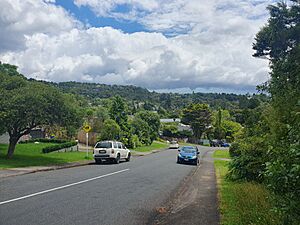Konini facts for kids
Quick facts for kids
Konini
|
|
|---|---|
|
Suburb
|
|
 |
|
| Country | New Zealand |
| Local authority | Auckland |
| Electoral ward | Waitākere ward |
| Local board | Waitākere Ranges Local Board |
| Area | |
| • Land | 236 ha (583 acre) |
| Population
(June 2023)
|
|
| • Total | 4,940 |
Konini is a lovely suburb located in West Auckland, New Zealand. It is governed by the Auckland Council. The name Kōnini comes from the Māori-language and refers to the fruit of the native tree fuchsia.
Geography of Konini
Konini is surrounded by beautiful native bush on its western side. To the east, you'll find peaceful suburban streets. Konini Road is a long, winding street that connects the suburb of Glen Eden to the amazing Waitākere Ranges and its native rainforest.
This area is part of a special natural zone called the Waitematā-Waitākere foothills. The Waitākere Ranges protect Konini from the Tasman Sea. Long ago, this area was covered in huge forests of kauri, Phyllocladus trichomanoides (also known as tānekaha or celery pine), and rimu trees. You would also find many nīkau palm trees and silver ferns. The soil here is a mix of volcanic soil from the Miocene period and Waitemata Group sedimentary rock.
History of Konini
The land where Konini now stands has a rich history. It is part of the traditional area, or rohe, of Te Kawerau ā Maki. This is an iwi (a Māori tribe) whose ancestors were among the very first people to live in the Auckland Region. West Auckland was once known as Hikurangi. The upper parts of Te Wai-o-Pareira / Henderson Creek were called Ōkaurirahi. This name refers to the large kauri forests that grew there.
In the early days of European settlement in Auckland, much of Konini and the nearby area of Kaurilands was owned by Hibernia Smythe. He was an immigrant from Liverpool who gathered about 550 acres of land between 1854 and 1857. This land was just north of Titirangi. Smythe used his land for cutting wood, logging, and also for farming sheep and cattle.
Konini Road was built during the 1920s. This was when the neighbouring Kaurilands area was being developed with new houses. Southern Konini also started to be divided into smaller plots for homes between the 1920s and 1940s. Konini School opened its doors in May 1976. It was built on land that used to be an orchard and a dairy farm, as more and more houses were being built in the area.
Population and People in Konini
Konini covers an area of about 2.36 square kilometers. As of 2023, it had an estimated population of about 4,926 people. This means there are about 2,087 people living in each square kilometer.
The population has grown steadily over the years:
- In 2006, there were 3,393 people.
- In 2013, the population grew to 4,689.
- By 2018, it was 4,854.
- In 2023, the population reached 4,926.
The 2023 New Zealand census showed that Konini had 2,433 males and 2,460 females. About 1,089 people (22.1%) were under 15 years old. There were 831 people (16.9%) aged 15 to 29, and 2,460 people (49.9%) aged 30 to 64. About 546 people (11.1%) were 65 years or older.
Konini is a diverse place with people from many backgrounds. The census showed that:
- 74.2% identified as European (Pākehā).
- 12.5% identified as Māori.
- 11.6% identified as Pasifika.
- 16.6% identified as Asian.
- 2.7% identified as Middle Eastern, Latin American, and African New Zealanders (MELAA).
- 1.9% identified with other ethnicities.
Most people in Konini speak English (96.1%). Other languages spoken include Māori (2.1%) and Samoan (2.2%). About 30.3% of the people in Konini were born outside New Zealand.
Many people in Konini have different religious beliefs. About 26.2% identified as Christian. Other religions like Hinduism, Islam, Māori religious beliefs, and Buddhism are also present. A large number of people (57.9%) said they had no religion.
When it comes to education, many adults in Konini have completed higher studies. About 34.1% of people aged 15 or older had a bachelor's degree or higher. Another 48.1% had a post-high school certificate or diploma. Most adults (57.5%) were employed full-time.
Education in Konini
Konini School is a primary school for children in years 1 to 6. It is a coeducational school, meaning both boys and girls attend. As of July 2024, the school has about 370 students. Konini School first opened in 1976.
For secondary education, students in Konini can attend Kelston Boys' High School and Kelston Girls' College.



